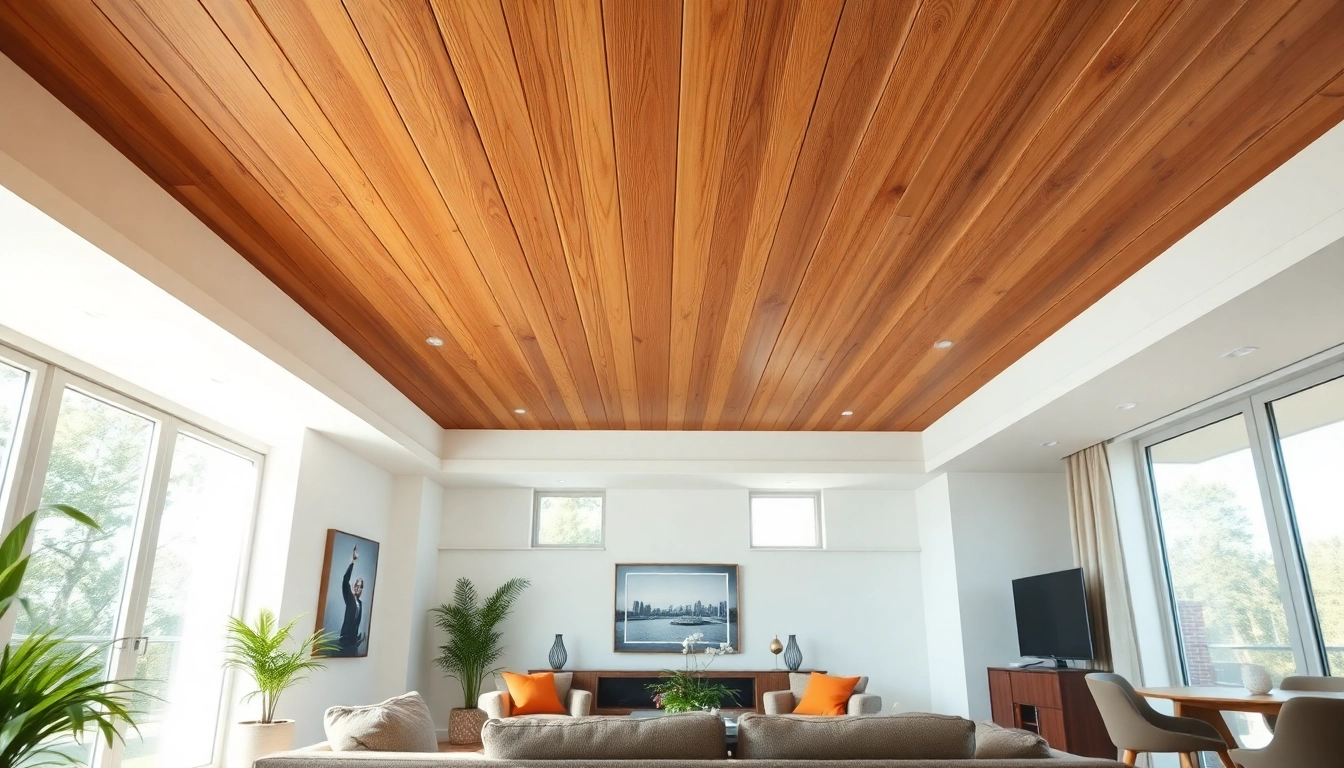Understanding Wood Panels for Ceilings
What Are Wood Panels for Ceilings?
Wood panels for ceilings are specially designed boards made from various types of wood that are used to enhance the visual aesthetics of a space. They can be installed in residential or commercial properties to create a warm and inviting atmosphere. These panels can range from tongue-and-groove planks to decorative slats or even engineered wood options, depending on the look and function desired. One of the standout features of wood panels for ceilings is their ability to add texture and character to otherwise bland ceiling spaces while improving acoustics and insulation when installed properly. They contribute significantly to the overall interior design, making spaces feel more homely and luxurious.
Types of Wood Panels for Ceilings
When considering wood panels for ceilings, it’s essential to understand the various types available, as each type offers a unique aesthetic and practical benefit:
- Natural Wood Panels: These panels are made from solid wood, showcasing the natural grains and colors of the wood species used, such as oak, maple, or walnut. They are favored for their durability and classic look.
- Engineered Wood Panels: Comprised of layers of wood composite, these panels can be more affordable and environmentally friendly. They often mimic the appearance of solid wood and can be treated for better moisture resistance.
- Reclaimed Wood Panels: Sourced from previously used wood products, reclaimed panels provide a unique rugged charm. This option is not only eco-friendly but adds historical context and character to a space.
- Acoustic Wood Panels: Specifically designed to improve sound quality in a room, these panels are engineered to absorb sound and reduce echo, making them ideal for spaces like recording studios, auditoriums, and home theaters.
Benefits of Using Wood Panels for Ceilings
The advantages of utilizing wood panels for ceilings extend beyond mere aesthetics:
- Aesthetic Appeal: Wood panels can dramatically elevate the design of any room, providing warmth, sophistication, and style.
- Improved Acoustics: Many wood panels enhance sound quality, reducing noise levels and providing a more pleasant auditory environment.
- Insulation: Wood offers natural insulation properties, helping to regulate temperature and save on energy costs.
- Sustainability: When sourced from responsibly managed forests, wood panels can be an eco-friendly choice, reducing carbon footprints and supporting sustainable practices.
- Variety: With countless styles, finishes, and types of wood to choose from, there’s something for every taste and design theme.
Design Ideas Using Wood Panels for Ceilings
Modern Living Spaces
For modern interiors, wood panels for ceilings can serve as a stunning focal point. Consider using wide planks painted in light or neutral tones to maintain a spacious feeling while adding texture. Incorporating contrasting trim or beams can enhance the contemporary vibe, and pairing these panels with minimalist decor creates a cohesive and sleek look.
Traditional and Rustic Styles
In traditional or rustic settings, reclaimed wood panels can infuse charm and authenticity. Darker stained woods or wood panels with intricate carvings add character, while a coffered ceiling can combine elegance with a homely feel. Integrating other natural materials, like stone or brick, can establish a comfortable and inviting atmosphere.
Creative Applications in Different Rooms
Wood panels are highly versatile and can be used creatively across various rooms:
- Living Rooms: Install a grid pattern or diagonal layout to create visual interest, complemented by accent lighting.
- Bedrooms: Consider using lighter woods for a serene environment, or install panels behind the bed as a feature wall.
- Kitchens: Use wood panels to create a warm and inviting atmosphere, especially above islands or dining areas.
- Bathrooms: Water-resistant options or treated panels can contribute to spa-like spaces while ensuring durability in humid areas.
Installation Tips for Wood Panels for Ceilings
Preparing the Space
Before installation, proper preparation of the space is crucial. Clear the area of furniture and fixtures, measure the ceiling dimensions accurately, and ensure that the surface is clean and smooth. Inspect for any signs of water damage or mold; addressing these issues beforehand will ensure the longevity of the installation.
Tools and Materials Needed
Having the right tools ensures a smoother installation process. Essential items include:
- Measuring tape
- Level
- Plywood or furring strips (if needed for support)
- Nails or screws appropriate for wood
- Wood adhesive
- Electric saw for cutting panels
- Safety gear, including goggles and gloves
Step-by-Step Installation Guide
Here’s a simplified process for installing wood panels on your ceiling:
- Measure & Mark: Use your measuring tape and level to mark lines on the ceiling where the panels will hang.
- Prepare the Panels: Cut the panels to fit appropriate measurements, avoiding raw edges by sanding them if needed.
- Install Support (if necessary): Attach furring strips to provide a solid substrate for the panels.
- Adhere Panels: Start at one end and work your way across, applying adhesive or securing with nails/screws as you go, ensuring everything is level.
- Finishing Touches: Fill any holes or gaps, sand down rough edges, and apply a finish to enhance the wood’s beauty.
Maintenance and Care for Wood Panels for Ceilings
Cleaning and Upkeep
Regular maintenance is essential for preserving wood panels’ beauty. Dust the ceiling monthly using a soft broom or microfiber cloth to prevent buildup. For deeper cleaning, a damp cloth with a mild cleaner should suffice, but avoid excessive moisture that can warp the wood.
Preventing Damage
To ensure your wood panels remain in excellent condition, pay attention to humidity levels in the room, as excessive moisture can lead to warping or mold growth. Use proper ventilation in kitchens and bathrooms, and monitor temperature swings that can cause wood to expand or contract.
Restoration Techniques
If your wood panels begin to show signs of wear, restoration can breathe life back into them. Light sanding can remove surface stains, while staining or varnishing can refresh their appearance. For deeper scratches and blemishes, a wood filler can be used effectively to create a smooth finish.
Comparing Wood Panel Options for Ceilings
Cost Considerations
Pricing for wood panels can vary significantly based on material, finish, and type. Solid wood panels often come at a premium, while engineered and composite options can provide more budget-friendly alternatives without sacrificing style. It’s essential to assess your budget not just for materials but also for installation costs, if hiring professionals.
Durability and Longevity
Durability can be a significant factor when determining which type of wood panel to use. Solid wood is incredibly durable if maintained correctly, whereas engineered wood may resist moisture and warping, making it ideal for specific environments. Always review product specifications and warranties when choosing to ensure you’re getting a panel matched to your needs.
Eco-Friendly Alternatives
Environmental considerations are increasingly influencing material choices in home improvement. Many manufacturers now offer eco-friendly wood panels made from reclaimed wood or responsibly sourced timber, providing a sustainable choice without compromising aesthetic appeal. Using locally sourced materials can also help minimize the carbon footprint associated with transportation.















Leave a Reply